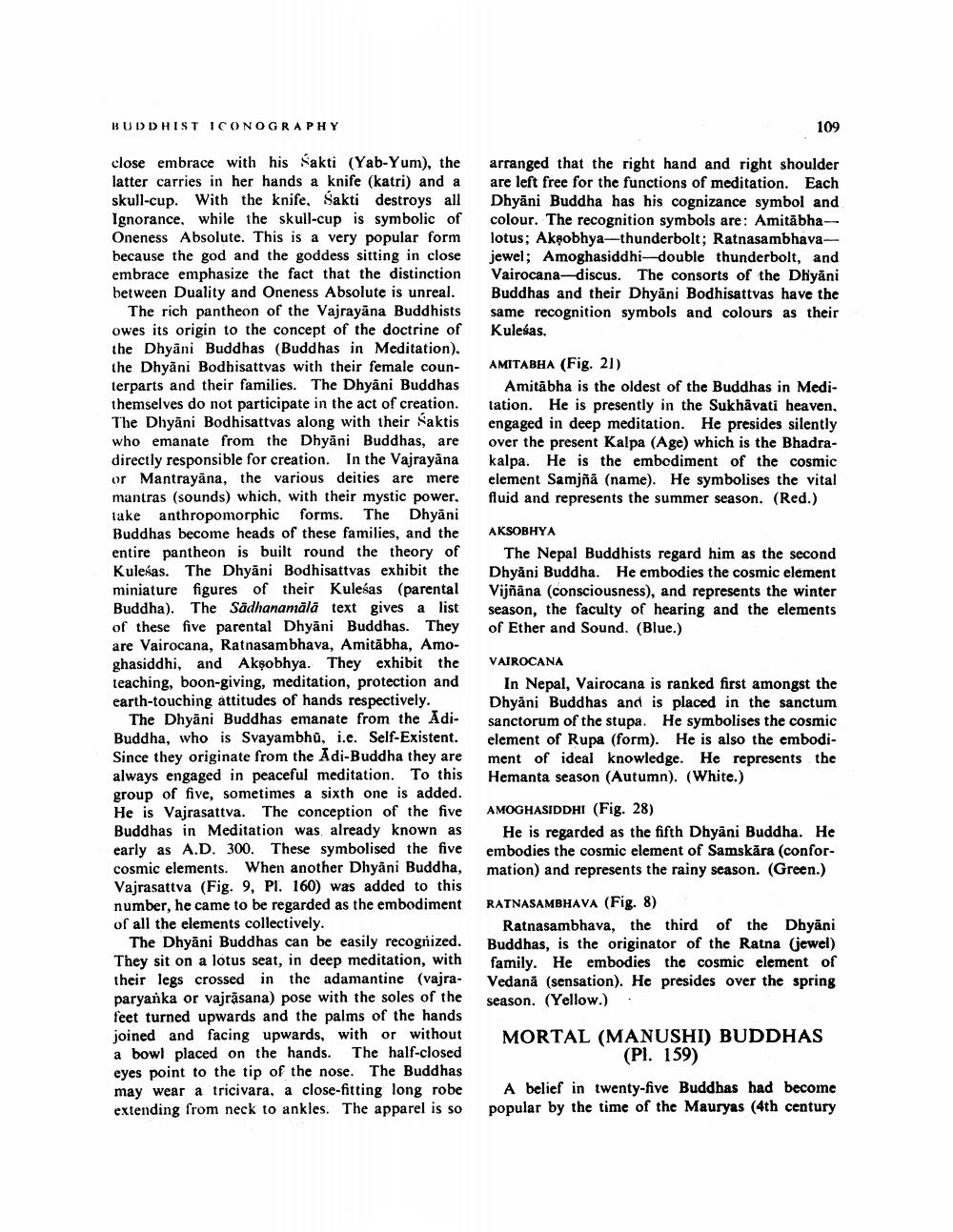________________
BUDDHIST ICONOGRAPHY
close embrace with his Sakti (Yab-Yum), the latter carries in her hands a knife (katri) and a skull-cup. With the knife, Sakti destroys all Ignorance, while the skull-cup is symbolic of Oneness Absolute. This is a very popular form because the god and the goddess sitting in close embrace emphasize the fact that the distinction between Duality and Oneness Absolute is unreal.
The rich pantheon of the Vajrayana Buddhists owes its origin to the concept of the doctrine of the Dhyani Buddhas (Buddhas in Meditation). the Dhyani Bodhisattvas with their female counterparts and their families. The Dhyani Buddhas themselves do not participate in the act of creation. The Dhyani Bodhisattvas along with their Saktis who emanate from the Dhyani Buddhas, are directly responsible for creation. In the Vajrayana or Mantrayana, the various deities are mere mantras (sounds) which, with their mystic power. take anthropomorphic forms. The Dhyani Buddhas become heads of these families, and the entire pantheon is built round the theory of Kulešas. The Dhyani Bodhisattvas exhibit the miniature figures of their Kulešas (parental Buddha). The Sadhanamālā text gives a list of these five parental Dhyani Buddhas. They are Vairocana, Ratnasambhava, Amitabha, Amoghasiddhi, and Akṣobhya. They exhibit the teaching, boon-giving, meditation, protection and earth-touching attitudes of hands respectively.
The Dhyani Buddhas emanate from the AdiBuddha, who is Svayambhu, i.e. Self-Existent. Since they originate from the Adi-Buddha they are always engaged in peaceful meditation. To this group of five, sometimes a sixth one is added. He is Vajrasattva. The conception of the five Buddhas in Meditation was already known as early as A.D. 300. These symbolised the five cosmic elements. When another Dhyani Buddha, Vajrasattva (Fig. 9, Pl. 160) was added to this number, he came to be regarded as the embodiment of all the elements collectively.
The Dhyani Buddhas can be easily recognized. They sit on a lotus seat, in deep meditation, with their legs crossed in the adamantine (vajraparyanka or vajrasana) pose with the soles of the feet turned upwards and the palms of the hands joined and facing upwards, with or without a bowl placed on the hands. The half-closed eyes point to the tip of the nose. The Buddhas may wear a tricivara, a close-fitting long robe extending from neck to ankles. The apparel is so
109
arranged that the right hand and right shoulder are left free for the functions of meditation. Each Dhyani Buddha has his cognizance symbol and colour. The recognition symbols are: Amitabhalotus; Akşobhya-thunderbolt; Ratnasambhavajewel; Amoghasiddhi-double thunderbolt, and Vairocana discus. The consorts of the Dhyani Buddhas and their Dhyani Bodhisattvas have the same recognition symbols and colours as their Kulešas.
AMITABHA (Fig. 21)
Amitabha is the oldest of the Buddhas in Meditation. He is presently in the Sukhāvati heaven, engaged in deep meditation. He presides silently over the present Kalpa (Age) which is the Bhadrakalpa. He is the embodiment of the cosmic element Samjñā (name). He symbolises the vital fluid and represents the summer season. (Red.)
AKSOBHYA
The Nepal Buddhists regard him as the second Dhyani Buddha. He embodies the cosmic element Vijñāna (consciousness), and represents the winter season, the faculty of hearing and the elements of Ether and Sound. (Blue.)
VAIROCANA
In Nepal, Vairocana is ranked first amongst the Dhyani Buddhas and is placed in the sanctum sanctorum of the stupa. He symbolises the cosmic element of Rupa (form). He is also the embodiment of ideal knowledge. He represents the Hemanta season (Autumn). (White.)
AMOGHASIDDHI (Fig. 28)
He is regarded as the fifth Dhyani Buddha. He embodies the cosmic element of Samskara (conformation) and represents the rainy season. (Green.)
RATNASAMBHAVA (Fig. 8)
Ratnasambhava, the third of the Dhyani Buddhas, is the originator of the Ratna (jewel) family. He embodies the cosmic element of Vedanā (sensation). He presides over the spring season. (Yellow.)
MORTAL (MANUSHI) BUDDHAS (Pl. 159)
A belief in twenty-five Buddhas had become popular by the time of the Mauryas (4th century




